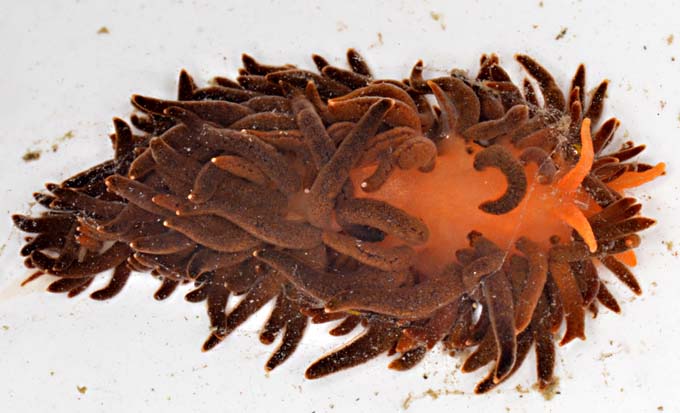This species has been observed on Reunion, Mayotte Maurice and Madagascar Islands
Species characteristics : The translucent pale orange body has many short plumb cerata which varie in colour depending upon the diet, but always with an orange or white tips. Colour varies from bright to dull orange, brown and black The rhinophores and oral tentacles are both long, smooth and translucent orange deepening in colour towards the tips
|

|
|
| Showing species characteristics... | Photo Sophie Darnis |
|
Remarks :
Identification confirmed by Bill Rudman
Synonymous : (according Worms)
- Phestilla melanobranchia Bergh, 1874
Bibliographic data :
A central band along the body is clear of cerata
The foot is large and the corners are rounded anteriorly
The rhinophores which araised from a common base are smooth and relatively short
It has both black and bright orange/yellow colour forms, the colour matching the colour of the Dendrophylliid coral on which specimens are feeding. Studies by Larry Harris (1968) showed that pigments in the coral tissue are taken up in the digestive gland, giving the nudibranch a coloration similar to its food.The orange/yellow colour form on Tubastraea coccinea, T. faulkneri or Dendrophyllia sp and the dark green/black form on T. micrantha and T. diaphana
Tenellia melanobrachia is observed in Tubastraea coral habitat on the undersides of shaded overhangs or in caverns. It has also been found on the undersides of rocks. It lives in moderately protected to highly exposed areas from 2-43 m
The nudibranchs are typically concealed in adjacent cracks during the day. They emerge at night to feed.
Larry Harris reported many years ago that this aeolid seemed to prefer feeding on pieces of coral that had broken off and were lying on the bottom below the main colony.
The spawn consists of numerous creamish, cup-shaped spirals attached to the host coral by their narrow end
Species of Tenellia are closely related to Cuthona, but lack a sac at the tip of the cerata to store nematocysts
References :
Bill Rudman Seaslug site : Sea Slug Forum : Phestilla melanobrachia
Nudipixel Phestilla melanobrachia
Publications :
Cella, K; Carmona Barnosi, L.; Ekimova, I; Chichvarkhin, A; Schepetov, D; Gosliner, T. M. (2016). A radical solution: The phylogeny of the nudibranch family Fionidae. PLoS ONE. 11(12): e0167800.
Harris, L.G. (1968) Notes on the biology and distribution of the aeolid nudibranch (Gastropoda), Phestilla melanobrachia Bergh, 1874. Publications of the Seto Marine Biological Laboratory, 16 : 193-198,2Pls.
Harris, L.G. (1975) Studies on the life history of two coral-eating nudibranches of the genus Phestilla . Biol. Bull., 149(3) : 539-550.
Gosliner.T. (1980) The systematics of the Aeolidacea of the Hawiian Islands with the descriptions of two new species. Pacif. Sci 31 : 37-77
Rudman, W.B. (1981a) Further studies on the anatomy and ecology of opisthobranch molluscs feeding on the scleractinian coral Porites . Zoological Journal of the Linnean Society, 71 : 373-412
Other photos of Tenellia melanobrachia :
Alain-Benoît Rassat Madagascar, Nosy bé, 21 m, 15 September 2014, size : 40 mm Three specimen on the same coral. Colour varies from bright to dull orange, brown and black |
 |
 |
Sophie Darnis Reunion, Saint Gilles, "vallée aux Mérous", 37 m, 12 December 2010, size : 10-15 mm Studies by Larry Harris (1968) showed that pigments in the coral tissue are taken up in the digestive gland (a), giving the nudibranch a coloration similar to its food. |
Maurice Jay Reunion, T.melanobrachia on its food : Tubastraea sp  |
 |
 |
Alain-Benoît Rassat Madagascar, Charlie point, Nosy bé, 17 m, 29 August 2012, size : 20 mm for the larger The rhinophores and oral tentacles are both long, smooth and translucent orange deepening in colour towards the tips (a). |
Norbert Verneau Mayotte, Quai des Douanes, 2 m, 13 February 2013. The translucent pale orange body has many short plumb cerata which varie in colour depending upon the diet, but always with an orange or white tips. Colour varies from bright to dull orange, brown and black |
 |
.jpg) |
Yann Von arnim Mauritius, Ferme Marine de Mahebourg, 20 m, 27 June 2017, size : 35 mm
|
If you have taken a photo of this species in Sud West Indian Ocean, please Contact us...